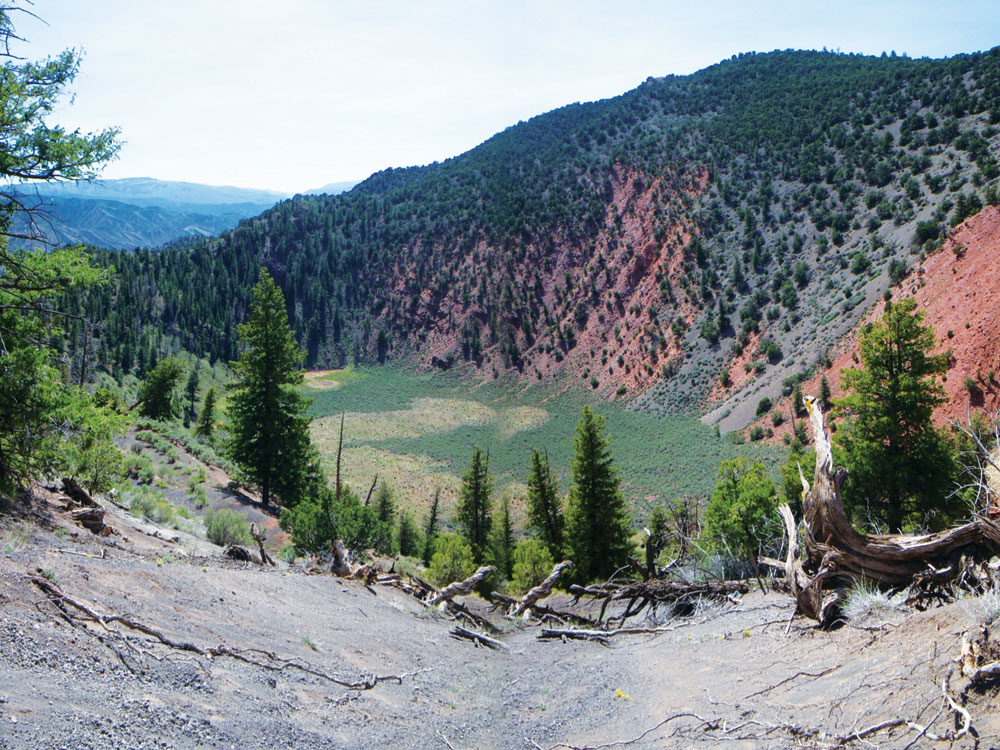 Colorado’s got a ton of volcanoes. One of ’em blasted out the biggest eruption in all of Earth history. Others produced some of our most important diamond, gold and fossil deposits.
Colorado’s got a ton of volcanoes. One of ’em blasted out the biggest eruption in all of Earth history. Others produced some of our most important diamond, gold and fossil deposits.
If you imagine the Earth as a giant avocado, Earth’s “pit” is a radioactive core of ultra-hot metal. It’s surrounded by a hot gooey layer called the mantle (the guacamole ingredient). We live on the skin of the avocado—perched on tectonic plates that cruise around atop the mantle like bumper-cars. Where plates collide, one of them often gets shoved down toward the mantle, where it sweats out water and many of its gases. These cause nearby rock to melt into magma, which then burbles upward toward the surface. This process has happened many times beneath Colorado.

The Dotsero Crater is a ½ mile wide, ¼ mile deep volcano located a mile north of I-70 east of Dotsero. It is Colorado’s youngest volcano. Photo by Big-g@restlessadventurer.net.
Depending on its chemistry, magma erupts in two main forms—oozing or explosive. Lava that oozes out gently forms a rock called basalt, thick flows of which cool slowly and develop dramatic vertical columns (think: Devil’s Tower). Colorado’s Flat Tops are a great example—they’re frosted with so much basalt that they don’t have jagged peaks like the rest of the Rockies. When the blend of volatile gases and water is just right, magma blasts upward and outward as ash and vapor, forming slippery soils and muds like those near Silverton, Creede and Del Norte.
Perhaps Colorado’s coolest volcano is northwest of Fort Collins, where there’s a 10-mile-wide ring representing a remnant volcanic neck. This so-called kimberlite pipe is so prominent you can see it from outer space. What’s unique about it is that it carried diamonds from the mantle up to the surface—making Colorado one of only two states that are rich in diamonds (the other is Arkansas).
The easiest belch of a volcano for Front Rangers to ogle is the one that produced North and South Table Mountain. These flat-topped mesas formed as lava spurted from the Ralston Dike about 2 miles northwest of N. Table Mountain, filling in local valleys and streams with a lake of lava. This volcanic vent erupted at least four different times, about 60 million years ago. Fast forward to today, and the softer strata that surrounded these valley-filling flows have eroded away—leaving the resistant caps of fossil lava behind. To see these up close, drive Highway 58 between Wheat Ridge and Golden. Or better yet, hike to the top of its volcano-scape, starting at the Table Mountain Trailhead off Highway 93.
Colorado’s most famous volcanoes erupted about 35 million years ago, destroying nearly all life in the region and producing two gigantic Pompeii-like deposits. At Florissant, about 60 miles west of Colorado Springs, ash eruptions and ash avalanches dammed a nearby river. The water backed up, creating a huge lake in which animals and plants were frequently buried. The fine ash helped to preserve delicate fossils like leaves and insects; it even entombed a grove of giant sequoia trees. Check them out in Florissant National Monument, or if you’d like to collect, stop by the “pay-to-dig” in town.
About 100 miles southwest of the Springs is the big kahuna of volcanoes—the San Juan Volcanic Field. It is so immense it’s hard to fathom. Among its many eruptions was one that expelled nearly 5,000 times the amount of material produced by Mount St. Helens. Enough debris was ejected to cover the state with a six-inch-thick blanket of hot ash. This killed many plants and animals, and contaminated the air so much that sunlight would have been blocked enough to reduce temperatures by one to three degrees for quite a while. Glad we missed that one.
Although the last eruption in the San Juans was 30 million years ago, the earth is still hot below the surface. Water percolating down and back up again produces many of the area’s hot springs—Mount Princeton and Conundrum among them.
Our cutest volcano erupted a mere 4,100 years ago. Look for it next time you’re driving west on I-70, about a mile before you hit Dotsero. On your right is the reddish-brown edge of the half-mile-wide crater. On your left is the lava flow that flowed southward from the crater and dammed the Eagle River. The resulting basalt and its frothy cousin, scoria, is currently being mined for landscape stone.
The Rockies are still volcanically active—witness the supervolcano that burbles beneath Yellowstone. But not to worry—seismic (earthquake-monitoring) networks will give us plenty of time to leave the blast zone beforehand.
So if you dig volcanoes and a trip to Hawaii isn’t in the budget, perhaps take a road trip this summer. Visit some of our very own, and very awesome, volcanoes.
James Hagadorn, Ph.D., is a scientist at the Denver Museum of Nature & Science. Suggestions and comments are welcome at jwhagadorn@dmns.org.

Is Engelmann Peak just South of Empire a former volcano? It’s apparently also called Crater Peak on some websites. Great view of it headed South on Rte 40 by Berthoud Pass. If it is a inactive volcano wondering when it last erupted if that data is available.
Is there anyone the specialized in volcanos that would come to a youth center and talk to kids.
Didn’t Silverton mountain erupt…. Very recently. Uh when the fuhhck are you assholes gonna show the rest of the world what’s happened. My son Trey lives in Silverton with my ex Josh and I have no way to physically check on them. The satellites footage shows shit that doesn’t look right or old pictures depending on the app. Truth is confusing but why would there be a reason to lie? Hmm or cover-up shit. Currupt Ass mothafuhhca’s= the government of this country and or shit bernardino county’s gov along with their crooked ass punk pass birch police that don’t do shit right and including wiping after they shit and all the other shit they secretly witness and harvest and unknowingly digest and taste cuz.. Fuhhking a most of the people u victimize u have preparing your fuhhkinh pig as big macs and shit. Sheeet.
great website :))
Was the source of magma for Dotsero the same as for Grand Mesa/Battlement Mesa? While attending school nearby, I helped a professor who was mapping deposits of river gravels directly beneath the basalt that caps Grand Mesa, here’s the kicker: The gravels that got covered by the lava match the modern gravels a vertical mile below in the modern CO River! I always thought that was so fascinating.
Great article! I actually found it via your Instagram account which I also enjoy. If hard pressed, I would quickly admit to envying your job. Keep up the great work.
what is the name of the volcano between Buena Vista and Nathrop? It is near Ruby Mtn. The rafting guides talk about it when you are rafting down the Arkansas river in that area..
He may have been talking about Big Baldy Mountain, which is further south near Salida. It’s an extinct stratovolcano. It has a well preserved, slightly younger vent named “The Crater” just below it’s rim. It is hikeable. There are many extinct volcanic plugs and vents in that area, so he may not have been talking about that one. This is due to the ignimbrite flare up 40 million years ago, and also due to it’s location on the potentially active Rio Grande rift zone, which produced volcanic eruptions as recently as the past few thousand years in New Mexico.
And, nobody has been around to witness just how rapid a complex multiple block faulting area forms like the Rio Grande Rift when the mantle gives way during a megaquake that may surpass that from a subducting plate boundary zone like that of the Cascadian..
What plate is Dotsero located on? I am doing a project and the sites that I went on did not explain.
Are we talking about tectonic plates? If so, it is on the North American plate, along with most of the rest of Colorado. James
It sure looks like one, but more likely this scoop-shaped structure is a feature produced by ice. As a glacier oozes downward, it often carves out a bowl-like depression at the top of a mountain. The underlying rock here, based on the geologic map, seems to be what’s called the “Silver Plume” granite, which is 1.4 billion years old. One ought to check this in person, though… so perhaps it’s time for a hike!
I have a question regarding Engelmann Peak near Berthoud Pass—-was it once a volcano? Looking at pictures of the face that is seen from Highway 40, it appears that it could have been. At least to my unscientific mind. I’ve not been able to find much information that would tell me yes or no. I thank you in advance should you choose to reply to this.